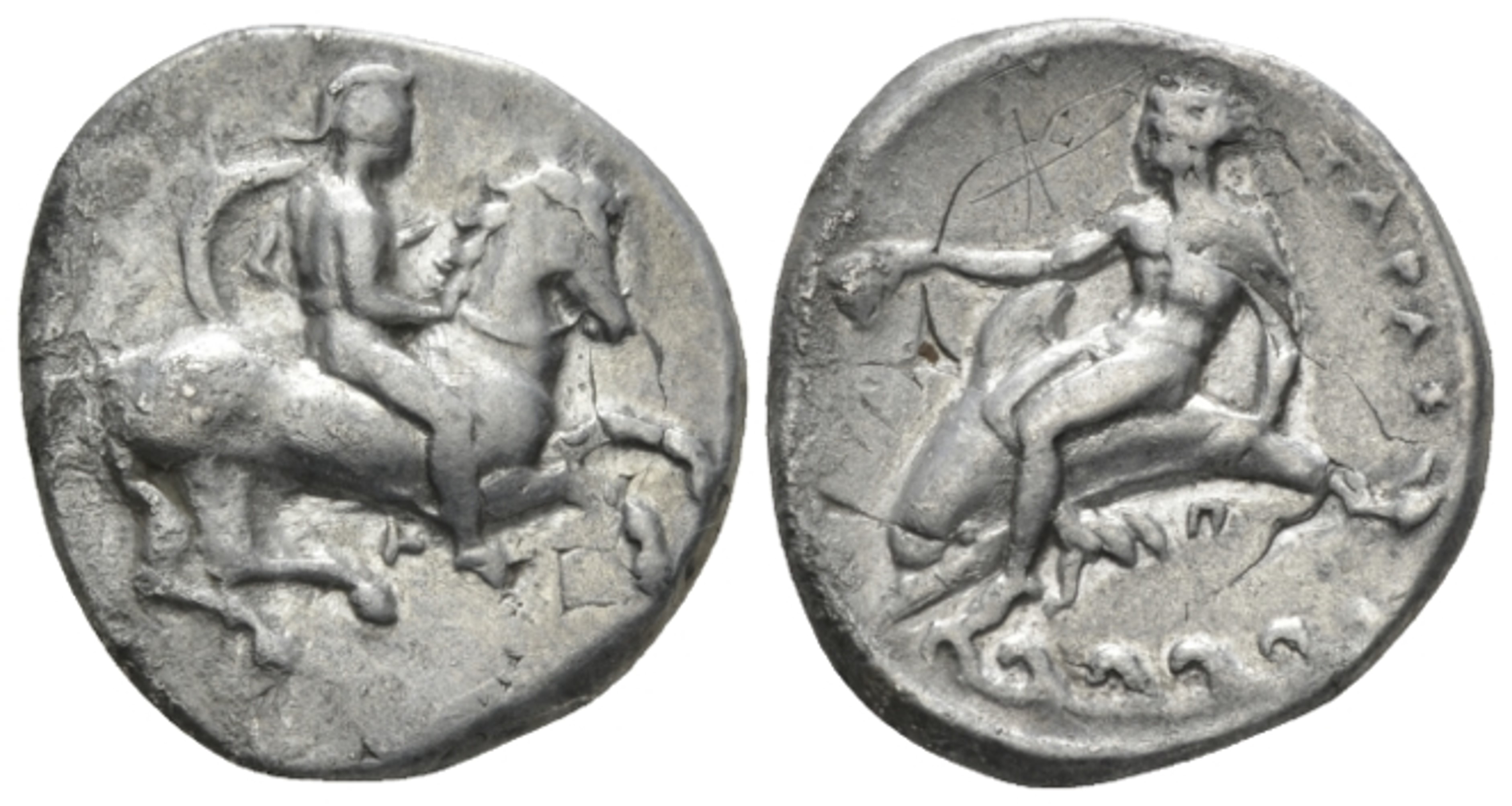345 BCE - 340 BCE | TAPAΣ
Overstriking coin
Taras_Naville_Numismatics, _28, _22_Jan._2017, _13.jpg
[1]
|
|
Sale(s)Sale(s) ᵖ:
|
Naville Numismatics, 28, 22 Jan. 2017, 13
|
|
|
|
Description
| ObverseInscription or printing placed on the obverse.:
|
Male character seated on horse galloping to right, naked, wearing helmet, holding reins in one hand and shield and spear in other. Below, T.
|
ReverseInscription or printing placed on the reverse.:
|
TAPAΣ (Greek) Male character (Taras or Phalanthos), nude, seated sideways on a dolphin to left, holding cantharos. Below, Π over wave pattern.
|
Mint and issuing power
| MintIdentifies the place of manufacture or issue of a numismatic object.:
|
Taras
|
Ancient regionAncient region.
|
Calabria
|
Modern countryModern country: Italy
|
AuthorityIdentifies the issuing power. The authority can be "pretended" when the name or the portrait of X is on the coin but he/she was not the issuing power. It can also be "uncertain" when there is no mention of X on the coin but he/she was the issuing power according to the historical sources:
|
|
Chronology
| FromIdentifies the initial date in a range assigned in a numismatic context. 345 BCE toIdentifies the final date in a range assigned in a numismatic context.. 340 BCE
|
Classical 480-323 BC  periodTime period of the numismatic object. periodTime period of the numismatic object.
|
Physical description
MetalThe physical material (usually metal) from which an object is made.: Silver 
|
WeightWeight of the numismatic object (in grams). in grams: 7.717.71 g <br />7,710 mg <br />
|
DenominationTerm indicating the value of a numismatic object. Examples: tetradrachm, chalkous, denarius.: nomos
|
|
| DiameterDescribes diameter of an object (in mm).: 2020 mm <br />2 cm <br />
|
|
References
Description
| ObverseInscription or printing placed on the obverse.:
|
TEPI-NAION around (Greek) Head of the nymph Terina right, hair in ampyx and tied into knot, tiny f behind neck
|
ReverseInscription or printing placed on the reverse.:
|
Nike, wings spread, holding kerykeion in right hand, wreath in left, seated left on stele
|
Mint and issuing power
| MintIdentifies the place of manufacture or issue of a numismatic object. ᵖ:
|
Terina
|
Ancient regionAncient region. ᵖ
|
Bruttium
|
Modern countryModern country: Italy
|
AuthorityIdentifies the authority in whose name (explicitly or implicitly) a numismatic object was issued. ᵖ:
|
|
Chronology
| FromIdentifies the initial date in a range assigned in a numismatic context. 425 BCE toIdentifies the final date in a range assigned in a numismatic context.. 420 BCE
|
Classical 480-323 BC  periodTime period of the numismatic object. periodTime period of the numismatic object.
|
Physical description
| DenominationTerm indicating the value of a numismatic object. Examples: tetradrachm, chalkous, denarius. ᵖ:
|
nomos
|
|
|
References
References
- ^ Ravel, Oscar E. (1990), Descriptive catalogue of the collection of Tarentine coins formed by M. P. Vlasto, London, Spink
- ^ Troxell, Hyla S. (1972), Sylloge Nummorum Graecorum: The collection of the American Numismatic Society. Part 2. Lucania, New York
- ^ Fischer-Bossert, Wolfgang (1999), Chronologie der Didrachmenprägung von Tarent, 510-280 v. Chr., Berlin, De Gruyter, xvii, 495 p., [84] pl.
- a b Rutter N. Keith et alii (eds.) (2001), Historia Numorum Italy, London, xvi, 223 p., 43 pl.
- ^ Hoover, Oliver D. (2018), The Handbook of Greek Coinage Series, Volume 1. Handbook of Coins of Italy and Magna Graecia, Sixth to First Centuries BC., Lancaster-London, 2018, lxi, 527 pages, 23 cm
- ^ Regling, Kurt (1906), Terina, Winckelmannsfeste der Archaeologischen Gesellschaft 66, Berlin, 80 p., 3 pl.

